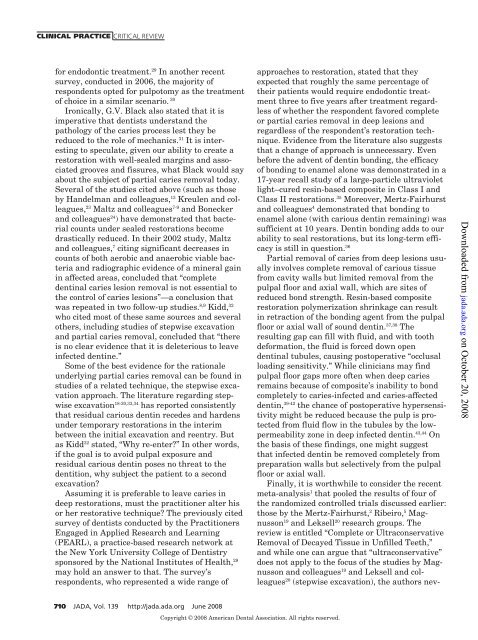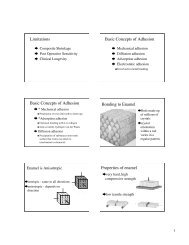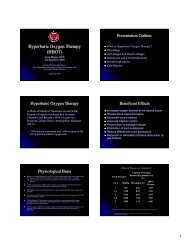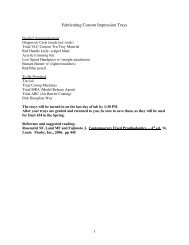Management of the deep carious lesion and the - Ohio State ...
Management of the deep carious lesion and the - Ohio State ...
Management of the deep carious lesion and the - Ohio State ...
Create successful ePaper yourself
Turn your PDF publications into a flip-book with our unique Google optimized e-Paper software.
CLINICAL PRACTICE CRITICAL REVIEW<br />
for endodontic treatment. 29 In ano<strong>the</strong>r recent<br />
survey, conducted in 2006, <strong>the</strong> majority <strong>of</strong><br />
respondents opted for pulpotomy as <strong>the</strong> treatment<br />
<strong>of</strong> choice in a similar scenario. 30<br />
Ironically, G.V. Black also stated that it is<br />
imperative that dentists underst<strong>and</strong> <strong>the</strong><br />
pathology <strong>of</strong> <strong>the</strong> caries process lest <strong>the</strong>y be<br />
reduced to <strong>the</strong> role <strong>of</strong> mechanics. 31 It is interesting<br />
to speculate, given our ability to create a<br />
restoration with well-sealed margins <strong>and</strong> associated<br />
grooves <strong>and</strong> fissures, what Black would say<br />
about <strong>the</strong> subject <strong>of</strong> partial caries removal today.<br />
Several <strong>of</strong> <strong>the</strong> studies cited above (such as those<br />
by H<strong>and</strong>elman <strong>and</strong> colleagues, 13 Kreulen <strong>and</strong> colleagues,<br />
23 Maltz <strong>and</strong> colleagues 7-9 <strong>and</strong> Bonecker<br />
<strong>and</strong> colleagues 24 ) have demonstrated that bacterial<br />
counts under sealed restorations become<br />
drastically reduced. In <strong>the</strong>ir 2002 study, Maltz<br />
<strong>and</strong> colleagues, 7 citing significant decreases in<br />
counts <strong>of</strong> both aerobic <strong>and</strong> anaerobic viable bacteria<br />
<strong>and</strong> radiographic evidence <strong>of</strong> a mineral gain<br />
in affected areas, concluded that “complete<br />
dentinal caries <strong>lesion</strong> removal is not essential to<br />
<strong>the</strong> control <strong>of</strong> caries <strong>lesion</strong>s”—a conclusion that<br />
was repeated in two follow-up studies. 8,9 Kidd, 32<br />
who cited most <strong>of</strong> <strong>the</strong>se same sources <strong>and</strong> several<br />
o<strong>the</strong>rs, including studies <strong>of</strong> stepwise excavation<br />
<strong>and</strong> partial caries removal, concluded that “<strong>the</strong>re<br />
is no clear evidence that it is deleterious to leave<br />
infected dentine.”<br />
Some <strong>of</strong> <strong>the</strong> best evidence for <strong>the</strong> rationale<br />
underlying partial caries removal can be found in<br />
studies <strong>of</strong> a related technique, <strong>the</strong> stepwise excavation<br />
approach. The literature regarding stepwise<br />
excavation 18-20,33,34 has reported consistently<br />
that residual <strong>carious</strong> dentin recedes <strong>and</strong> hardens<br />
under temporary restorations in <strong>the</strong> interim<br />
between <strong>the</strong> initial excavation <strong>and</strong> reentry. But<br />
as Kidd 32 stated, “Why re-enter?” In o<strong>the</strong>r words,<br />
if <strong>the</strong> goal is to avoid pulpal exposure <strong>and</strong><br />
residual <strong>carious</strong> dentin poses no threat to <strong>the</strong><br />
dentition, why subject <strong>the</strong> patient to a second<br />
excavation?<br />
Assuming it is preferable to leave caries in<br />
<strong>deep</strong> restorations, must <strong>the</strong> practitioner alter his<br />
or her restorative technique? The previously cited<br />
survey <strong>of</strong> dentists conducted by <strong>the</strong> Practitioners<br />
Engaged in Applied Research <strong>and</strong> Learning<br />
(PEARL), a practice-based research network at<br />
<strong>the</strong> New York University College <strong>of</strong> Dentistry<br />
sponsored by <strong>the</strong> National Institutes <strong>of</strong> Health, 29<br />
may hold an answer to that. The survey’s<br />
respondents, who represented a wide range <strong>of</strong><br />
710 JADA, Vol. 139 http://jada.ada.org June 2008<br />
Copyright © 2008 American Dental Association. All rights reserved.<br />
approaches to restoration, stated that <strong>the</strong>y<br />
expected that roughly <strong>the</strong> same percentage <strong>of</strong><br />
<strong>the</strong>ir patients would require endodontic treatment<br />
three to five years after treatment regardless<br />
<strong>of</strong> whe<strong>the</strong>r <strong>the</strong> respondent favored complete<br />
or partial caries removal in <strong>deep</strong> <strong>lesion</strong>s <strong>and</strong><br />
regardless <strong>of</strong> <strong>the</strong> respondent’s restoration technique.<br />
Evidence from <strong>the</strong> literature also suggests<br />
that a change <strong>of</strong> approach is unnecessary. Even<br />
before <strong>the</strong> advent <strong>of</strong> dentin bonding, <strong>the</strong> efficacy<br />
<strong>of</strong> bonding to enamel alone was demonstrated in a<br />
17-year recall study <strong>of</strong> a large-particle ultraviolet<br />
light–cured resin-based composite in Class I <strong>and</strong><br />
Class II restorations. 35 Moreover, Mertz-Fairhurst<br />
<strong>and</strong> colleagues 4 demonstrated that bonding to<br />
enamel alone (with <strong>carious</strong> dentin remaining) was<br />
sufficient at 10 years. Dentin bonding adds to our<br />
ability to seal restorations, but its long-term efficacy<br />
is still in question. 36<br />
Partial removal <strong>of</strong> caries from <strong>deep</strong> <strong>lesion</strong>s usually<br />
involves complete removal <strong>of</strong> <strong>carious</strong> tissue<br />
from cavity walls but limited removal from <strong>the</strong><br />
pulpal floor <strong>and</strong> axial wall, which are sites <strong>of</strong><br />
reduced bond strength. Resin-based composite<br />
restoration polymerization shrinkage can result<br />
in retraction <strong>of</strong> <strong>the</strong> bonding agent from <strong>the</strong> pulpal<br />
floor or axial wall <strong>of</strong> sound dentin. 37,38 The<br />
resulting gap can fill with fluid, <strong>and</strong> with tooth<br />
deformation, <strong>the</strong> fluid is forced down open<br />
dentinal tubules, causing postoperative “occlusal<br />
loading sensitivity.” While clinicians may find<br />
pulpal floor gaps more <strong>of</strong>ten when <strong>deep</strong> caries<br />
remains because <strong>of</strong> composite’s inability to bond<br />
completely to caries-infected <strong>and</strong> caries-affected<br />
dentin, 39-42 <strong>the</strong> chance <strong>of</strong> postoperative hypersensitivity<br />
might be reduced because <strong>the</strong> pulp is protected<br />
from fluid flow in <strong>the</strong> tubules by <strong>the</strong> lowpermeability<br />
zone in <strong>deep</strong> infected dentin. 43,44 On<br />
<strong>the</strong> basis <strong>of</strong> <strong>the</strong>se findings, one might suggest<br />
that infected dentin be removed completely from<br />
preparation walls but selectively from <strong>the</strong> pulpal<br />
floor or axial wall.<br />
Finally, it is worthwhile to consider <strong>the</strong> recent<br />
meta-analysis 1 that pooled <strong>the</strong> results <strong>of</strong> four <strong>of</strong><br />
<strong>the</strong> r<strong>and</strong>omized controlled trials discussed earlier:<br />
those by <strong>the</strong> Mertz-Fairhurst, 2 Ribeiro, 5 Magnusson<br />
19 <strong>and</strong> Leksell 20 research groups. The<br />
review is entitled “Complete or Ultraconservative<br />
Removal <strong>of</strong> Decayed Tissue in Unfilled Teeth,”<br />
<strong>and</strong> while one can argue that “ultraconservative”<br />
does not apply to <strong>the</strong> focus <strong>of</strong> <strong>the</strong> studies by Magnusson<br />
<strong>and</strong> colleagues 19 <strong>and</strong> Leksell <strong>and</strong> colleagues<br />
20 (stepwise excavation), <strong>the</strong> authors nev-<br />
Downloaded from<br />
jada.ada.org<br />
on October 20, 2008






